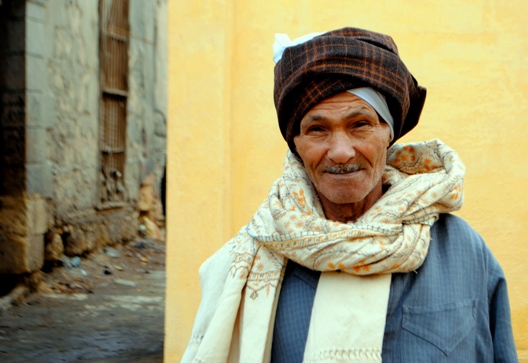 Tucked away in Cairo’s colorful Sayida Aisha cemetery, located near the Darb al-Ahmar district, resides 74-year-old ‘Am Amin, a local grave custodian, born and raised in the necropolis. “I have never left the cemetery, I was born and raised here, this is my home,” he says. ‘Am Amin a former carpet weaver by trade and father to seven children, three of which still reside in the cemetery invited EgyptSource into his world; a location off bounds to most strangers. His home, the grave – also his work space – offers a profoundly intimate understanding of lives lived behind the brightly painted decrepit walls of a cemetery.
Tucked away in Cairo’s colorful Sayida Aisha cemetery, located near the Darb al-Ahmar district, resides 74-year-old ‘Am Amin, a local grave custodian, born and raised in the necropolis. “I have never left the cemetery, I was born and raised here, this is my home,” he says. ‘Am Amin a former carpet weaver by trade and father to seven children, three of which still reside in the cemetery invited EgyptSource into his world; a location off bounds to most strangers. His home, the grave – also his work space – offers a profoundly intimate understanding of lives lived behind the brightly painted decrepit walls of a cemetery.
The ‘City of the Dead’ a mélange of colorful tombs and mausoleums stretches for several miles on the south-eastern border of Cairo, providing refuge to hundreds of thousands of poor Egyptians. The location of the ancient cemetery allegedly dates back to a graveyard established by the Arab conquerors of Egypt outside the city of al-Fustat, founded in 642 AD on the site of modern-day Cairo.
In the modern era, the exploding population, an increase in poverty encouraging rural and urban migration, and a housing shortage have all contributed to the relocation of people to the City of the Dead.
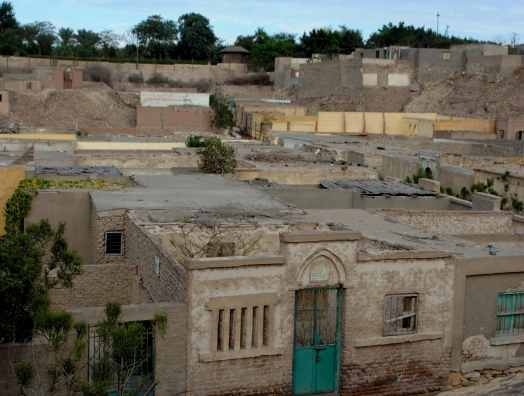
The Tomb and its Grave Guard
‘Am Amin sleeps in a tiny shabby room attached to a tomb housing the bodies of the deceased family he guards. Electricity is an unreliable luxury, which is inconsistent for most cemetery inhabitants.
“We don’t have electricity at the moment, it was cut off because of the cold weather,” he explains, sitting in a dark, unlit room. The only source of light comes from the open door.
The sparseness of ‘Am Amin’s home is reflective of the extent of the deprivation facing most tomb inhabitants. A small washing bowl and water tank which ‘Am Amin uses to bathe sit beneath a rope, serving as a washing line for his garments. Most graves lack bathroom facilities and running water. Inside his room, ‘Am Amin’s limited possessions are mostly packed into a rundown wooden cupboard.
“We lack all basic amenities; I wish the state would re-locate us to proper housing,” ‘Am Amin says. He is at least content knowing that his four daughters, having married, live outside the cemetery in residential apartments. Beside his bed is a small green radio, the only link to the world outside the cemetery for most residents. Some more fortunate residents have satellite dishes installed on the roofs of tombs. ‘Am Amin’s timid black dog, visibly malnourished like his owner, sits in a barren garden.
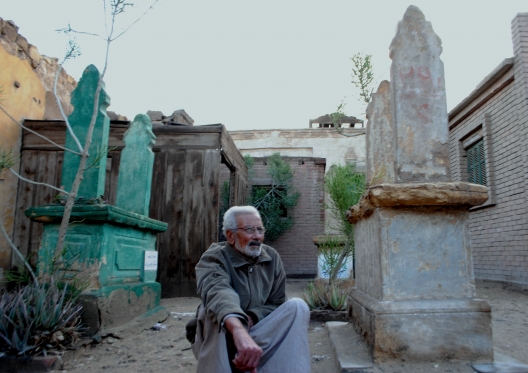
‘Am Amin’s typical day begins at 5 a.m. and consists of the mundane task of sitting in the grave from dawn to dusk. His unemployed 24-year-old son Reda, who lives with his wife ‘Um Reda’ in the family’s home, (another grave located close by) visits him daily, often bringing lunch.
Socio-Economic Woes
Traditionally, the position of custodian of the tombs is passed down through the generations of a family. Legally however they have no rights to the land. Grave inhabitants can be evicted by the government or the grave owners at any point, which is also the case for inhabitants of Cairo’s vast slums. Eviction is, however, unlikely as it would instigate too much turmoil; additionally a type of environmental-social balance has evolved given the residents generational land occupation.
“Egyptians are generally at ease with people living in their family graves, given the widespread poverty,” explains political sociologist Dr. Said Sadek, adding that the tomb dwellers also contribute by maintaining the grave’s upkeep.
Although Egyptians historically revere the dead, the grave guard and other tomb inhabitants confess that it is not by choice that they reside in the cemetery; but due to economic necessity. Such contempt to cemetery life is further exemplified by ‘Am Amin’s and his wife’s prejudice towards fellow tomb inhabitants.
“We would not have allowed our daughters to marry someone who lived here,” Um Reda says, adding that the tomb is not a civilized home.
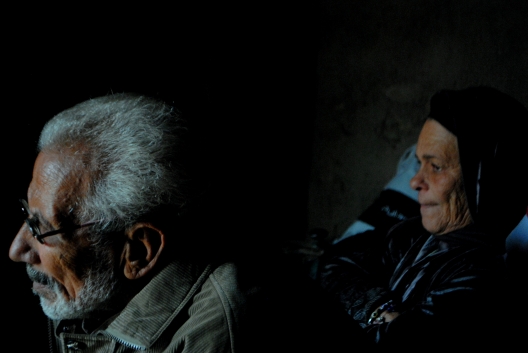
For his services, ‘Am Amin, like other grave guards is paid a meagre monthly income of around EGP 400 (US$57) per month. Although this fee should be higher, local grave keepers who don’t live in the cemetery functioning like a mafia, are allegedly hired by the government to split the income awarded by the tombs’ proprietors with grave guards like ‘Am Amin.
“They take 60 percent from the deceased’s family and leave us with 40 percent,” ‘Am Amin claims, after much prodding. It is a statement he was not initially willing to reveal, perhaps owing to security concerns.
With such inadequate resources, which have been further depleted by political and economic upheaval, most cemetery inhabitants like ‘Am Amin and his family are unable to provide sufficiently for their families. Prior to the revolution ‘Am Amin worked as a carpet weaver but, like many today, he is unable to find work and relies solely on the income generated guarding a tomb.
Concerns of the Youth
The aged grave guard’s son Reda offers an insight into the concerns of the necropolis’ many youths. Providing a guided tour of the rundown graveyard and the surrounding area, Reda discusses his and his youthful compatriots’ principal concerns.
“I used to be a trader at the Khan al-Khalili souq, but since the revolutions there has been no work, so I am just helping my father out now,” he says.
According to the 24-year-old most youths in the city of the dead, many of whom are educated, have been unable to find work over the last three years. Some resort to illicit activity, whether trading drugs or weapons. When asked whether he would like to follow in his father’s footsteps and become a custodian, Reda shows disinterest stating his preference to remain in the tourism sector. This appears to be the common sentiment among the younger generation, and their elders who likewise would prefer their children to work and reside outside the cemetery walls. “My dream is to get married and live in an actual apartment with my wife,” he explains.
Recreational activities are limited for youth and other residents; a small local cafe with an oversized television is the key source of entertainment. Politics also remains a preoccupation amongst many of the cemetery youths, with their political inclinations visibly displayed by the many posters of army head Abdel Fatah al-Sisi hanging on the cemetery walls. One young man has chosen a popular national song dedicated to the military chief as the ringtone on his mobile phone.
“We all hope Sisi will become the next president,” Reda says. In Sisi, they harbor a hope for stability and economic recovery. Reda reiterates the words of his elderly father maintaining that tomb inhabitants of all ages are Sisi loyalists following the June 30 revolution.
Between Reality and Dreams
Future prospects for ‘Am Amin and his fellow cemetery inhabitants were affected by the January 25 revolution in 2011. ‘Am Amin’s dreams of relocation were no longer so unlikely, as the Cairo governor’s office had initiated a new housing plan. New housing is, however, costly and while many have been relocated around Cairo, it is a lengthy process, one which fails to be a priority on the interim government’s agenda.
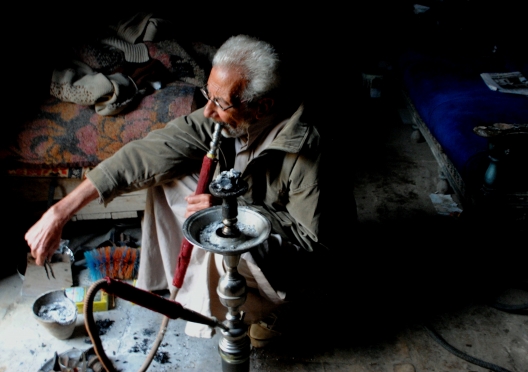
To make matters worse, in the wake of the revolution ‘Am Amin and his neighbors report a rise in unemployment and crime, as criminals exploit the security vacuum, stealing from tombs and often using the informal setting to trade drugs or hoard weapons.
Nonetheless, against the backdrop of the socio-economic concerns facing cemetery inhabitants, the elderly grave guard and his family—like many tomb dwellers—seek to remain in the unusual setting until the state offers a viable alternative solution.
“Alhamdulilah, thank God for everything. I hope one day to live in a residential apartment block with my family,” the elderly man says. Article 78 of Egypt’s recently ratified constitution not only guarantees a right to “safe and healthy housing,” but also mandates the drafting of a “national housing plan,” to address cases like that of ‘Am Amin. Providing infrastructure and facilities, as well as guaranteeing the provision of resources to implement the plan within a specific time frame, are the responsibility of the state. And so,’Am Amin waits.
Watch the video below by Sarah El-Rashidi, Dave Gutt and Ralph Avellino, giving viewers a closer look into the life of ‘Am Amin and his son Reda:
Sarah El-Rashidi graduated from Cambridge University with a Masters in International Relations, which encompassed a thesis focused on the Muslim Brotherhood’s pursuit of legitimacy under Mubarak.
Image: Photos: Sarah El-Rashidi
